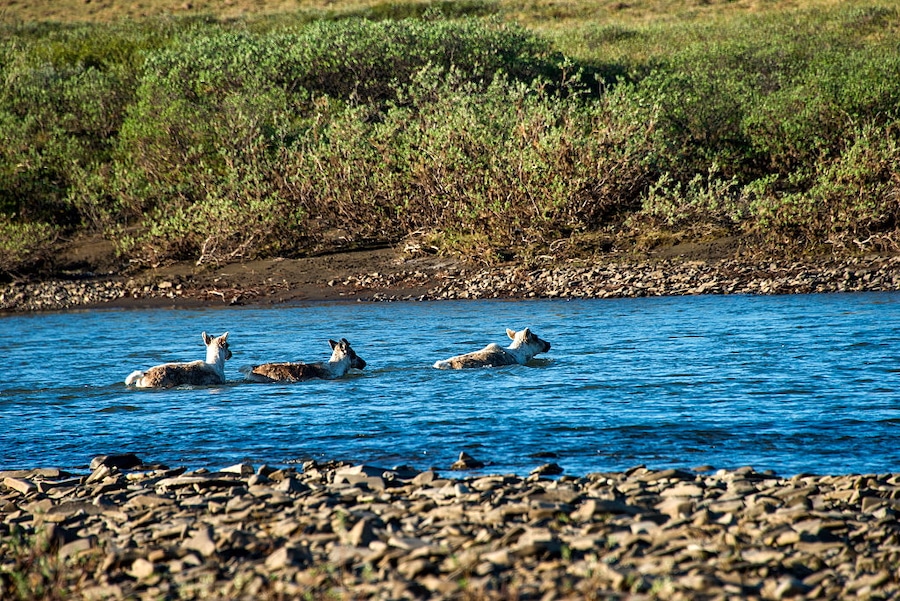This post was originally published on Eco Watch
United States Secretary of the Interior Doug Burgum announced on Monday that the federal government had proposed the reversal of a Biden-era order banning oil and gas drilling on the 23-million acre National Petroleum Reserve on Alaska’s North Slope. The remote area is home to a diverse array of wildlife, including threatened polar bears, caribou and migratory birds.
A press release from the Interior Department said that, following a “thorough legal and policy review,” officials from the department and the U.S. Bureau of Land Management (BLM) concluded that a 2024 BLM rule restricting oil and gas development in the reserve exceeded agency authority.
It cited conflicts with the purpose of the Naval Petroleum Reserves Production Act of 1976, saying the regulation imposed “unnecessary barriers to responsible energy development in the National Petroleum Reserve in Alaska.”
Burgum, U.S. Energy Secretary Chris Wright and Environmental Protection Agency Administrator Lee Zeldin traveled to Alaska this week to attend a series of events that included an annual sustainable energy conference hosted by Governor Mike Dunleavy, which began Tuesday in Anchorage, reported the Alaska Beacon.
Dan Sullivan, Republican senator from Alaska, called efforts to restrict oil and gas development in the National Petroleum Reserve-Alaska (NPR-A) the “most egregious effort of the Biden administration.”
“Congress was clear: the National Petroleum Reserve in Alaska was set aside to support America’s energy security through responsible development,” Burgum said in the press release. “The 2024 rule ignored that mandate, prioritizing obstruction over production and undermining our ability to harness domestic resources at a time when American energy independence has never been more critical.”
Environmental groups reacted to the announcement with anger and concern.
“The Trump administration’s move to roll back protections in the most ecologically important areas of the Western Arctic threatens wildlife, local communities, and our climate, all to appease extractive industries,” said Kristen Miller, executive director of Alaska Wilderness League, in a press release from the conservation organization. “These lands are home to caribou, migratory birds, and vital subsistence resources that Indigenous communities have relied on for generations. The public fought hard for these protections, and we won’t stay silent while they’re dismantled.”
Grandmothers Growing Goodness, an Iñupiat group that supports Arctic Indigenous communities, said repealing protections would substantially impact the Teshekpuk Lake area, an important habitat of the Teshekpuk caribou herd.
“The area is also integral to Indigenous subsistence practices, supporting hunting, fishing, and gathering,” the group said in a statement, as the Alaska Beacon reported.
Located roughly 600 miles from Anchorage, the NPR-A is bordered on the north by the Beaufort Sea and the Chukchi Sea on the west. It is the country’s largest remaining single tract of public land.
Created at the start of the last century as an emergency military fuel reserve, the NPR-A was opened by Congress to commercial development in 1976. However, lawmakers specified that importance should be placed on wildlife protections and land conservation measures, reported The Guardian.
“It’s hard to overstate the havoc this could wreak on the Western Arctic’s undisturbed habitat for caribou, polars bears and belugas,” said Marlee Goska, Alaska attorney with the Center for Biological Diversity, as the Alaska Beacon reported. “Trump’s fixation on plundering Alaska’s ecosystems for short-term gain is matched only by the stupidity of turning this precious place into a fossil fuel extraction site. Alaska’s vast expanses of wild lands are a big part of what makes our state so special, and we’ll do everything possible to protect these places.”
Fossil fuel emissions are the biggest contributor to the climate crisis. Alaska is warming two to three times faster than the global average, reported The New York Times, causing the melting of sea ice and thawing permafrost, which releases stored carbon back into the atmosphere.
From day one of his second term, President Donald Trump declared a “national energy emergency” with executive orders supporting the fossil fuel industry and his campaign mantra of “drill, baby, drill.”
However, Trump’s efforts to push drilling in Alaska have not been very popular. A proposed lease auction in the Arctic National Wildlife Refuge in January brought no bidders, The Guardian reported.
“This move will accelerate the climate crisis at a time when the ground beneath Alaska communities is literally melting away and subsistence foods are in decline,” said Matt Jackson, Alaska State senior manager with The Wilderness Society, as reported by The New York Times.
The post Trump Officials Open Millions of Acres of Alaska Wildlands to Oil and Gas Drilling appeared first on EcoWatch.





0 Comments